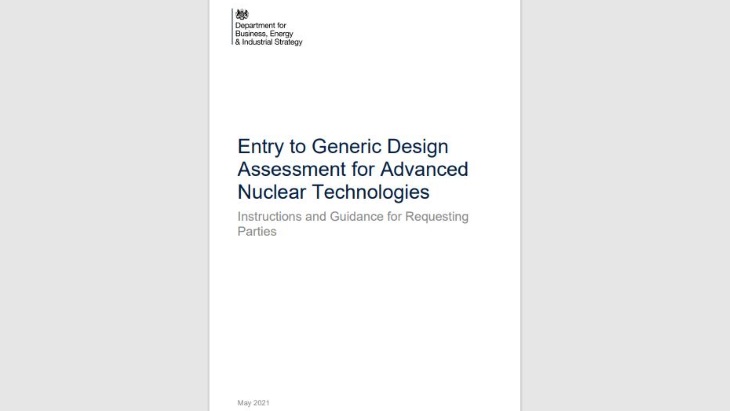GDA is a process carried out by the Office for Nuclear Regulation (ONR) and the Environment Agency (EA) to assess the safety, security, and environmental protection aspects of a nuclear power plant design that is intended to be deployed in Great Britain. Successful completion of the GDA culminates in the issue of a Design Acceptance Confirmation (DAC) from the ONR and a Statement of Design Acceptability (SoDA) from the EA. An applicant for GDA is known as the Requesting Party (RP).
In the foreword to the report - Entry to Generic Design Assessment for Advanced Nuclear Technologies Instructions and Guidance for Requesting Parties - Minister of State for Business, Energy and Clean Growth Anne-Marie Trevelyan noted that in the Ten Point Plan for a Green Industrial Revolution, which the government unveiled last November, nuclear power, whether large-scale, small-scale, or advanced, will have a key role to play in meeting the country's net-zero by 2050 goal. The plan also set target milestones for the first nuclear power plants using small modular reactors (SMRs) to be built in the UK by the early 2030s, alongside an advanced modular reactor (AMR) demonstration plant.
With the publication of the GDA guidance for advanced nuclear technologies, BEIS is "unlocking a key step on the path to their deployment" in the UK, Trevelyan said. "Opening GDA to advanced nuclear technologies this year, as the UK prepares to host COP26, showcases continued UK leadership in tackling climate change and the important role that nuclear has in our future net-zero energy mix," she added.
To be considered for entry into GDA, RPs for advanced nuclear technologies - which BEIS says is the collective term for SMRs and AMRs - must submit a GDA Entry Application to BEIS at GDAentry@beis.gov.uk.
New flexibilities
The report says that regulators have introduced "new flexibilities" to the GDA process to ensure the UK’s readiness for advanced nuclear technologies. This "modernised" GDA has three steps.
Step 1 initiates GDA and is where matters such as the scope and timescales are agreed. The regulators' knowledge of the design and the RP’s safety, security and environment cases increase, and the RP identifies any immediate gaps in meeting regulatory expectations and proposes how these will be subsequently resolved. The outcome is a Step 1 Statement which sets out the agreed scope and expectations for the subsequent GDA steps.
Step 2 is the fundamental assessment of the generic safety, security and environment protection cases, to identify any potential 'show-stoppers' that may preclude deployment of the design. The outcome of Step 2 is a formal statement of the regulators' findings.
Step 3 is the detailed assessment of the generic safety, security, and environment protection cases on a sampling basis. The outcome of Step 3 can be either DAC & SoDA as available in previous GDAs for nuclear power plants, or a Step 3 Statement of Regulators' findings depending upon the GDA scope agreed in Step 1, or an interim DAC and interim SoDA. Importantly, RPs may choose to exit from GDA at the end of Step 2, after receiving their GDA Step 2 Statement. This would be agreed in advance as part of the scope in Step 1.
Timings
BEIS anticipates the GDA process will following this approximate timetable: RPs submit a Notice of Intention to apply for GDA Entry to BEIS (three months before application); BEIS begins the evaluation process; RPs receive notification of their application result within three to four months; for successful applicants, this would be followed by a short period to agree cost recovery agreements with the regulators, before initiating the first stage of GDA.
The RP needs to produce four "readiness plans" - Programme Plan, Resource Plan, Finance Plan, and Security Plan. In a Business Plan Summary, RPs are asked to summarise and explain their longer-term commercial plan.
"If an RP intends to build commercial power plants, the RP should include information demonstrating how their design will be developed from its current position to commercial power plant deployment. Alternatively, if the RP’s plan is to develop a saleable product for others to build in the UK, the RP should include information demonstrating how they plan to achieve this," the document says.
Policy paper
In the policy paper on advanced nuclear technologies, BEIS said the Ten Point Plan and the 2020 Energy White Paper had confirmed the government's commitment to developing large, small and advanced nuclear projects.
The Ten Point Plan announced the Advanced Nuclear Fund of up to GBP385 million to invest in the next generation of nuclear. This includes up to GBP215 million for SMRs to develop a domestic smaller-scale power plant technology design, and up to GBP170 million for a research and development programme to deliver an AMR demonstrator by the early 2030s. An additional up to GBP40 million will be invested in developing the regulatory frameworks and supporting UK supply chains to help bring these technologies to market.
The paper defines advanced nuclear technologies by their "common attributes" - smaller than conventional nuclear power reactors, and designed so that much of the plant can be fabricated in a factory environment and transported to site, reducing construction risk and making them less capital-intensive. Generally advanced nuclear technologies fall into one of two groups, it says. These are Generation III water-cooled SMRs, similar to existing nuclear power reactors but on a smaller scale, and Generation IV and beyond AMRs, which use novel cooling systems or fuels to offer new functionality (such as industrial process heat) and potentially a step change reduction in costs.





_47120.jpg)

_23621.jpg)






